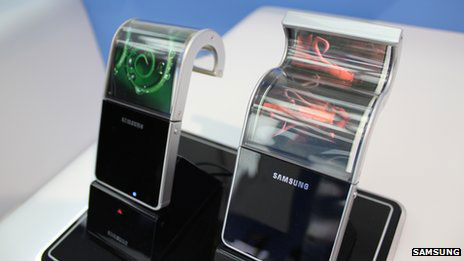Flexible, Bendable Graphene Smartphones May Be Coming In 2013
Like many electronic devices, the majority of today's smartphones aren't made to survive abuse. With new display technologies that are currently in development however, smartphones of the future may be more durable. These new display technologies enable flexible displays that can be rolled, dropped, squished, and stepped on without damage.
Although the dream of having a smartphone that can withstand such abuse may seem far-off, flexible display technology has been in development for a while now. We've seen prototypes at gadget shows, heard and seen demonstrations on various sites, and dreamed of the day when we can have our own flexible smartphone. New rumors suggest our dream may not be too far from reality. In fact, it's possible we could see the launch of the first flexible phone sometime next year.
Numerous manufacturers are working on creating a flexible smartphone, including LG, Philips, Sharp, Sony, Samsung, and Nokia. Reports suggest Samsung may be the first to actually deliver such a device, though an exact timeframe has not been announced.

Samsung will likely use flexible OLED (Organic Light Emitting Diode) technology in its flexible smartphones. According to a Samsung spokesperson, the displays used in the company's flexible smartphones will be "foldable, rollable, wearable and more, [and] will allow for a high degree of durability through their use of a plastic substrate that is thinner, lighter and more flexible than… conventional LCD technology."
The concept of creating flexible electronics using a flexible display and flexible plastic has been around since the 1960s. In 2005, Philips showed off a prototype of a rollable display. A few years later, Amazon incorporated e-ink flexible displays into its first Kindle e-reader. Since the components beneath Amazon's first-generation Kindle were rigid, most people didn't realize the device had a plastic-non-rigid screen.
Due to cost and other reasons, most of the e-ink displays used in devices today are hidden behind a rigid glass screen. In order to offer a finished product that is flexible, both the optical frontplane as well as the backplane which contains the transistors must be made of a flexible material. In addition, the device's battery, shell, touchscreen, and other components must also be flexible.

The flexible OLED technology Samsung is using isn't the only option on the market. Other flexible display technologies are also in the works. Prof Andrea Ferrari from Cambridge University is currently working on bendable displays that use graphene. Graphene is a sheet of carbon that's one atom thick. This substance is strong, transparent, lightweight, and flexible, which makes it perfect for use in electronics. In theory, graphene could be used to make displays, surfaces, and batteries used in electronic devices.
Regardless of which flexible display technologies become the standard, it's exciting to see progress being made in this field. What's even more exciting is the possibility that Samsung or another company could actually launch a flexible device in the not-too-distant future.

